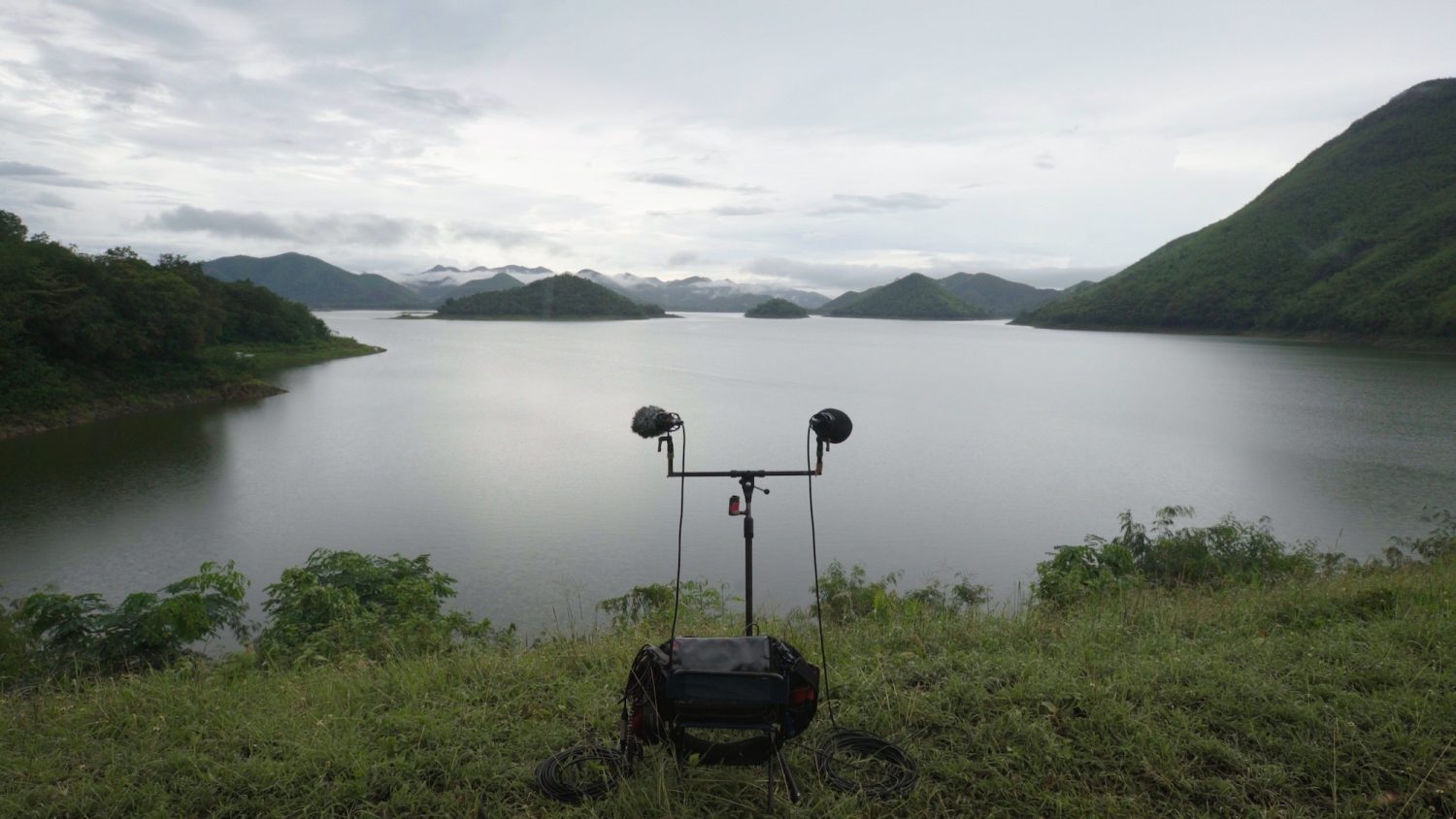Sorayos Prapapan and Lim Tingli in conversation
Read on for a recap of the Objectifs Film Club session featuring Thai filmmaker Sorayos “Yossy” Prapapan discussing his short film Death of the Sound Man with sound designer, re-recording mixer and foley artist Tingli Lim in June 2020. The conversation has been slightly paraphrased for clarity and brevity.
View the trailer for Death of the Sound Man by Sorayos Prapapan, and rent the film from the Objectifs Film Library.
Tingli: How did you conceive the idea for this film?
Yossy: I like to watch films about filmmaking, and many students like to make films about filmmaking too. Each time, the sound character is always a stupid guy: someone who puts the boom in the shot, someone who forgets to record the sound.
I mean, this is not my job! Your perception about sound in terms of filmmaking is so…unacceptable to me [laughs]! And I’m also a sound guy, so I wanted to make a film to highlight our career. The scenes in the film are mostly from my experience working as a sound man.
It’s also quite a political film. I feel that people in my country, the government, won’t hear us, whatever we talk, and sometimes the audience doesn’t really pay attention also, so I made it happen.
Tingli: So you’re saying that every scene that happened in the film happened in your real life? Was that why you left sound and became a director instead?
Yossy: Actually it’s not quite true to say that. I was a director first, but I knew that no one would want to hire a new graduate to be a director. I wanted to work on film sets in some position and back then I wanted to be an assistant director. But after a while, I quit my AD job. I liked to watch independent films, most of which had quite a different kind of sound. My knowledge of sound was quite limited so I interned in the sound department. It has helped me with directing as well.
Tingli: Yes, the film is quite a reflection of your emphasis on sound because the camera is very still and you use sound to bring our attention to different parts of a wide shot. It’s very rare for a director to let the sound lead the scene.
Yossy: I mean it’s automatic. I didn’t think about it that much!
Tingli: It’s almost like a still. The camera is static and the sound is leading the scene, carrying the scene forward. I’m also curious how much of the sound is actually production sound and how much of it you did in post-production, since you could get the mic so close, because the mic is in shot all the time. It’s a rare film where “boom in shot” is totally okay. Or is everything foley and recreated?
Yossy: What you hear as dialogue is all production sound. We did ask our actor to do ADR (automated dialogue replacement) for only one type of sound, like uh! hm! because we forgot in the film. In the end I did not use it. So all the dialogue is production sound, but for the foley it’s mixed.
I was the recordist myself but I didn’t do the boom. We had four shooting days. On the first day we did only the landscaping, so that was only myself as a sound guy, the cameraman, one driver and one assistant.
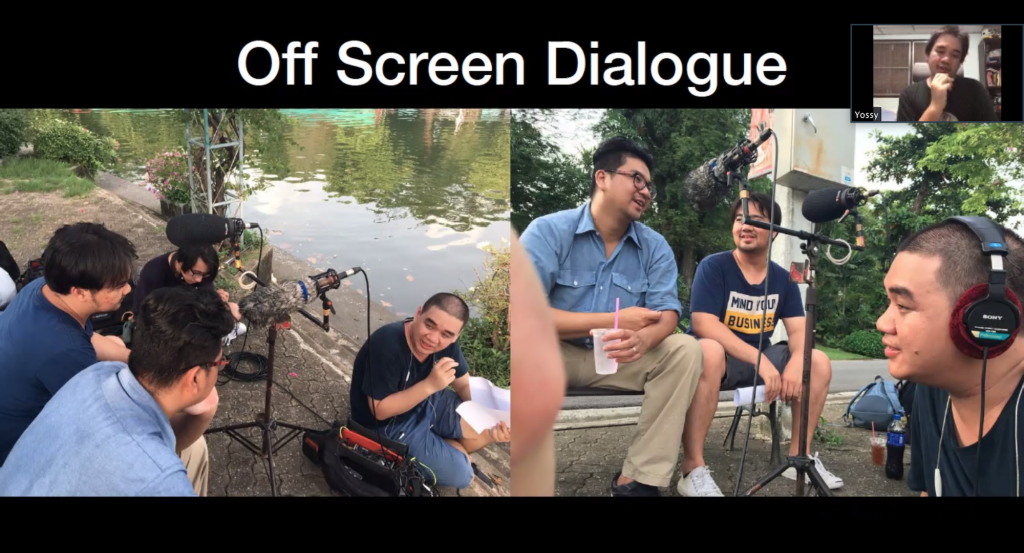
The long dialogue scene we recorded separately, but we used the same location because I was the sound editor and I’m quite bad at it, especially dialogue. If you record in the ADR room or any rooms somehow I still cannot believe it. So I decided to bring the microphone out on the same day to record outside. It was only two pages of dialogue, but we did it for like an hour. At that time, we sent the camera department to record some stock shots, and just only the sound department and actors stayed here in the most quiet we could find in that environment.
Tingli: It’s amazing. Because you used two booms, it’s gonna sound good.
Yossy: I want to say a bit about my actor. The guy with the glasses is the guy who taught me how to do sound.
Tingli: Oh, so they’re non-actors? So they are real live sound people.
Yossy: Yeah, so he is the editor of Apichatpong Weerasethakul. Every time we record the sound on set he mentors me again, even on the set. Many small details in the film were his idea. It’s a good thing that you use a real sound man to act in your film!
Tingli: Yeah, and he can mic himself… [laughs]
Yossy: We did around 12 takes of this scene, and the take that was perfect in terms of timing did not sound good, so we used the sound from a different take when editing.
They are all location sound, but I’m the director and producer of this film and I knew that I was going to be sound editing for this film also. For the lighting, it was only production sound, but for the background we cleaned it up a bit and added on a bit.
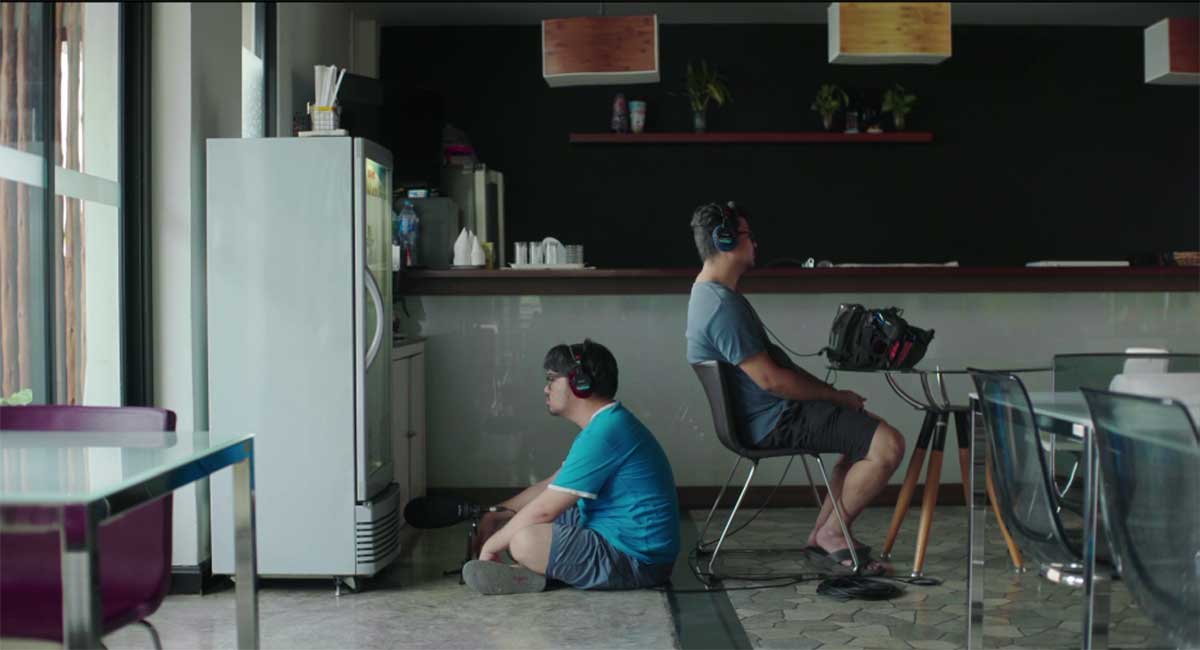
From “Death of the Sound Man” by Sorayos Prapapan
The mix was quite interesting for me, because the fridge in my house is so noisy. I walk past it everyday so I decided to record it, and I like the sound so much we created this scene [for the film]. This fridge in the film did not make a sound that I like, so we used a different sound.
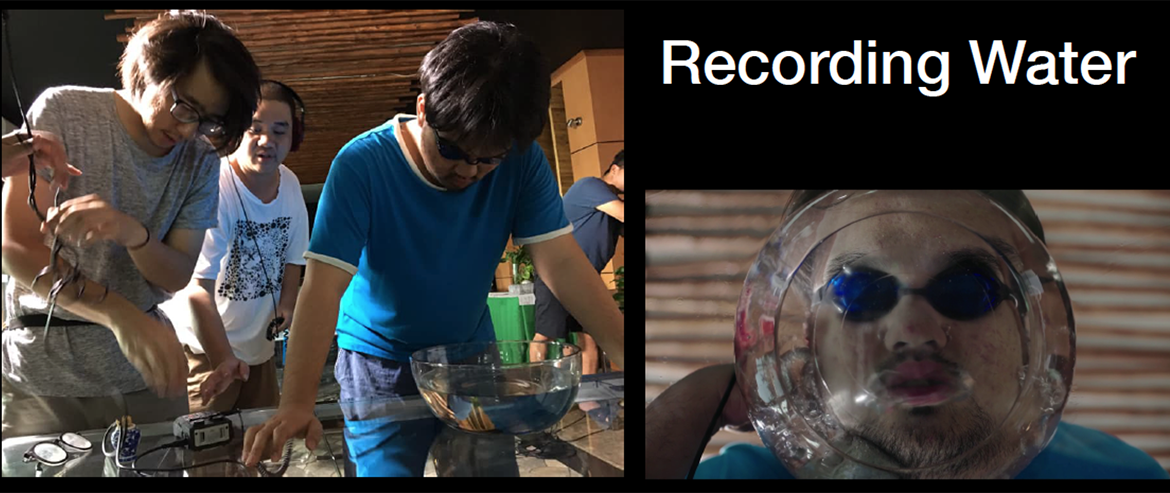
Yossy: For this we switched to a cheaper recorder, because the water gets in. We used one lavalier mic on the actor, one boom on the side. We didn’t get 100% what I wanted, we got about 70%. We wrapped this microphone in plastic and dipped it into the water and we used both sounds, the one in the water and outside the water.
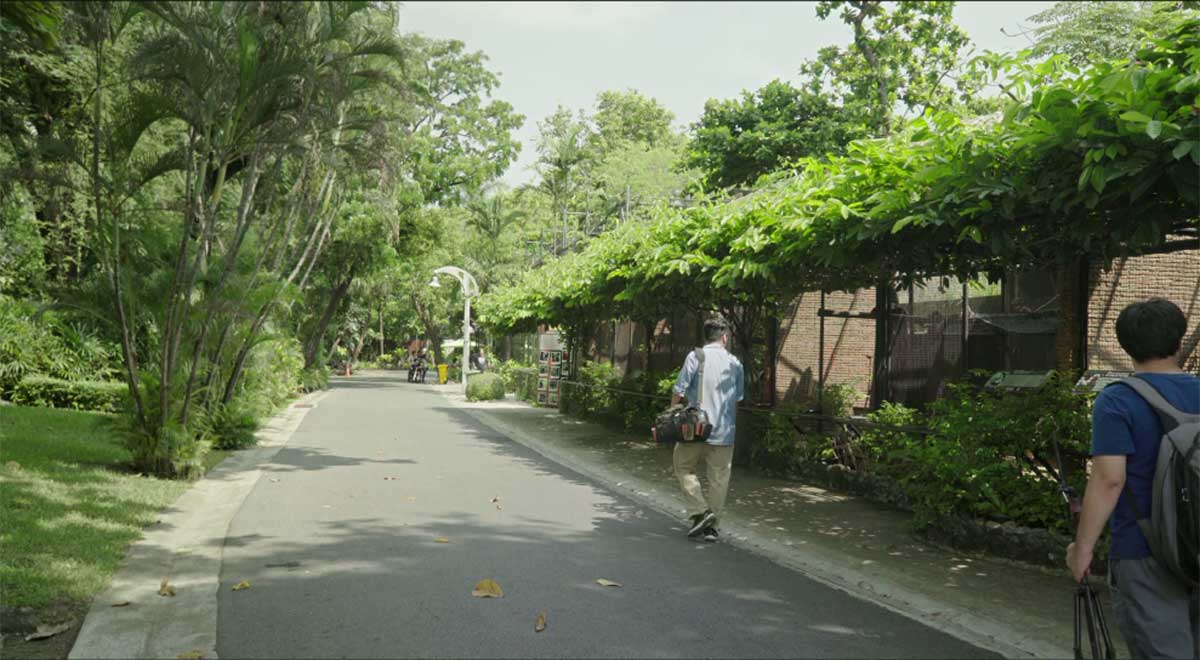
From “Death of the Sound Man” by Sorayos Prapapan
Yossy: This part is location sound but we have some footsteps, stamps, and clang clang, something like that. The insects are added on, and some birds are added on. But this location had a lot of crows and we heard them all the time. There is…I dunno what kind of bird, coo coo coo [editor’s note: like a koel], that sound is not heard much in Bangkok but I like it so much that I added it.
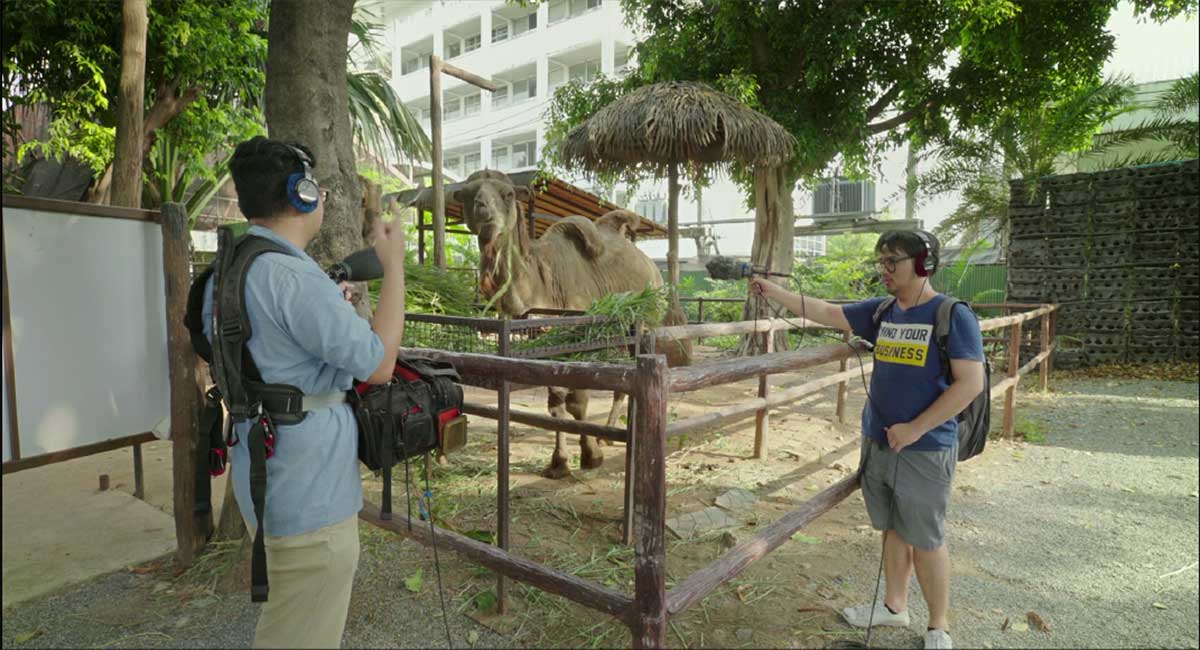
From “Death of the Sound Man” by Sorayos Prapapan
Yossy: The location of this scene was very noisy because it’s next to the road, and we heard motorcycles all the time but what you hear in the film is the location sound. We put the mic really close and the actor acted really well. We cut the rest of the sound off because we don’t want to hear the too noisy background.
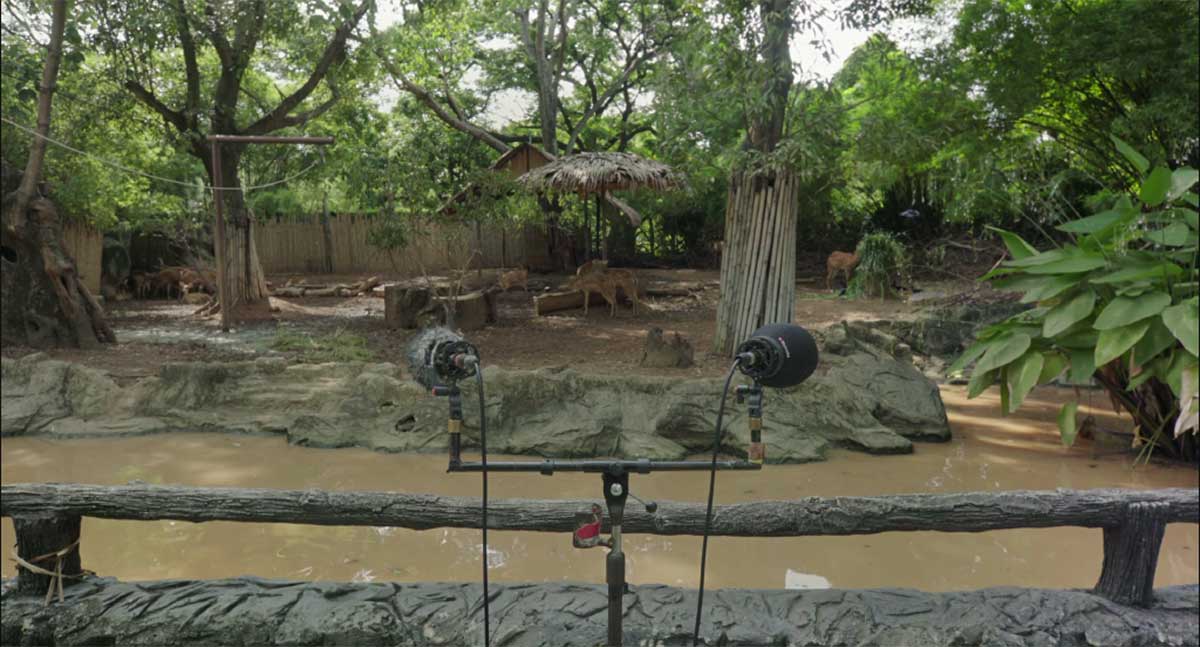
From “Death of the Sound Man” by Sorayos Prapapan
Yossy: In this scene, the sound was quite good, we could hear a lot of birds. I had to add more when the deer walk, we had to add deer footsteps and when we see the birds far away, we had to add the sound of flapping wings. But unfortunately my skill [to create the] footsteps of deer is really bad so we decided to remove it, and used only birds.
Tingli: This is interesting. Obviously you didn’t manage to capture it up close.
Yossy: Yeah, the sound when we shot the scene was really bad, and we could not go very close. If you remember the scene, there was no dialogue. But in the background, everything was quite silent and so my sound guy asked me to add some foley of the leopard panting — so I had to record myself!
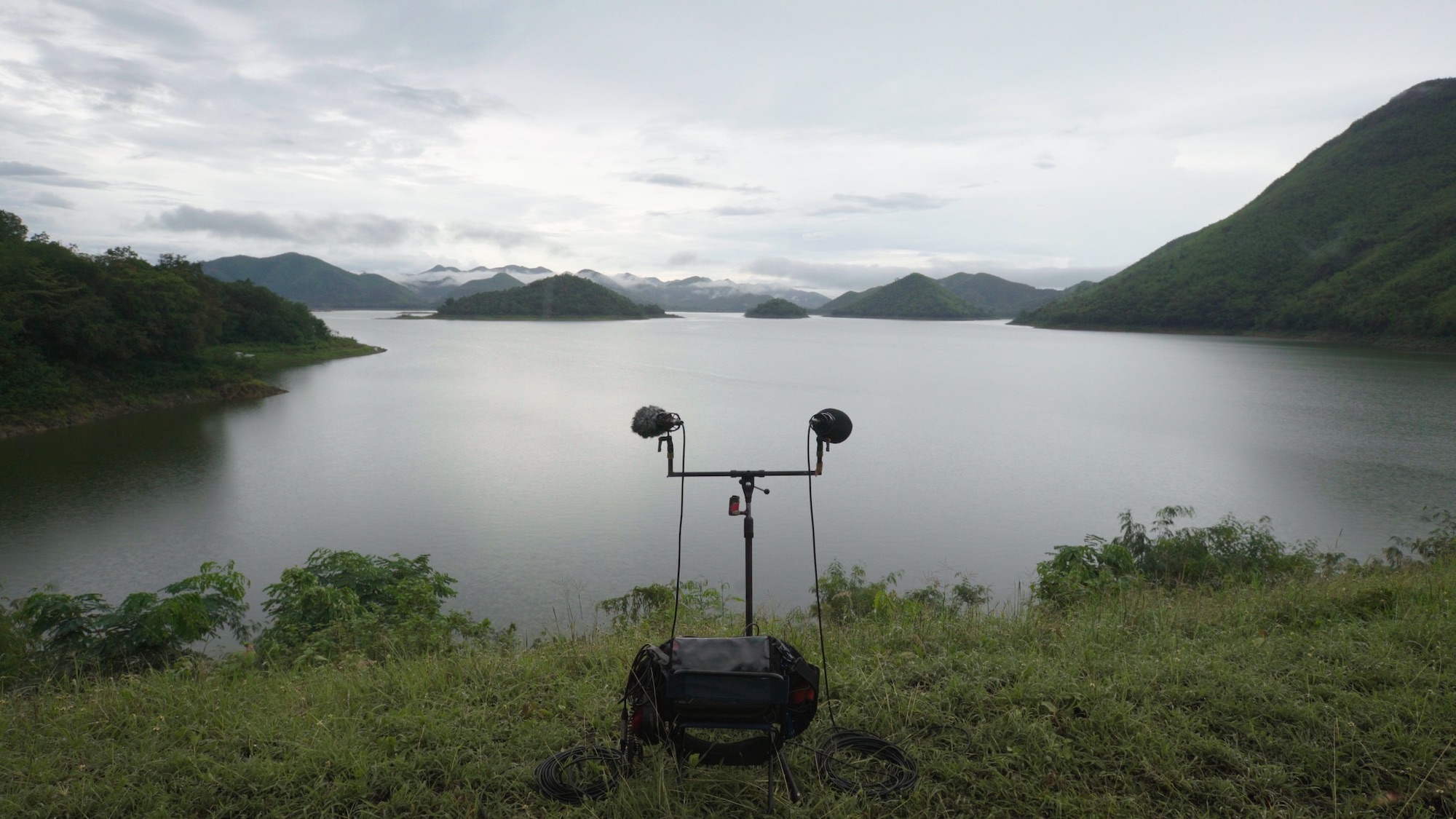
From “Death of the Sound Man” by Sorayos Prapapan
Yossy: When we shot here it rained and I liked the atmosphere, the image very much. But the rain got on the microphone all the time.
Tingli: So was that the sound that you recorded?
Yossy: Not at all, we hear the raindrops almost all the time. There were insects, red dragonflies. They flew past the microphone, so we had to figure out how to make insect sounds.
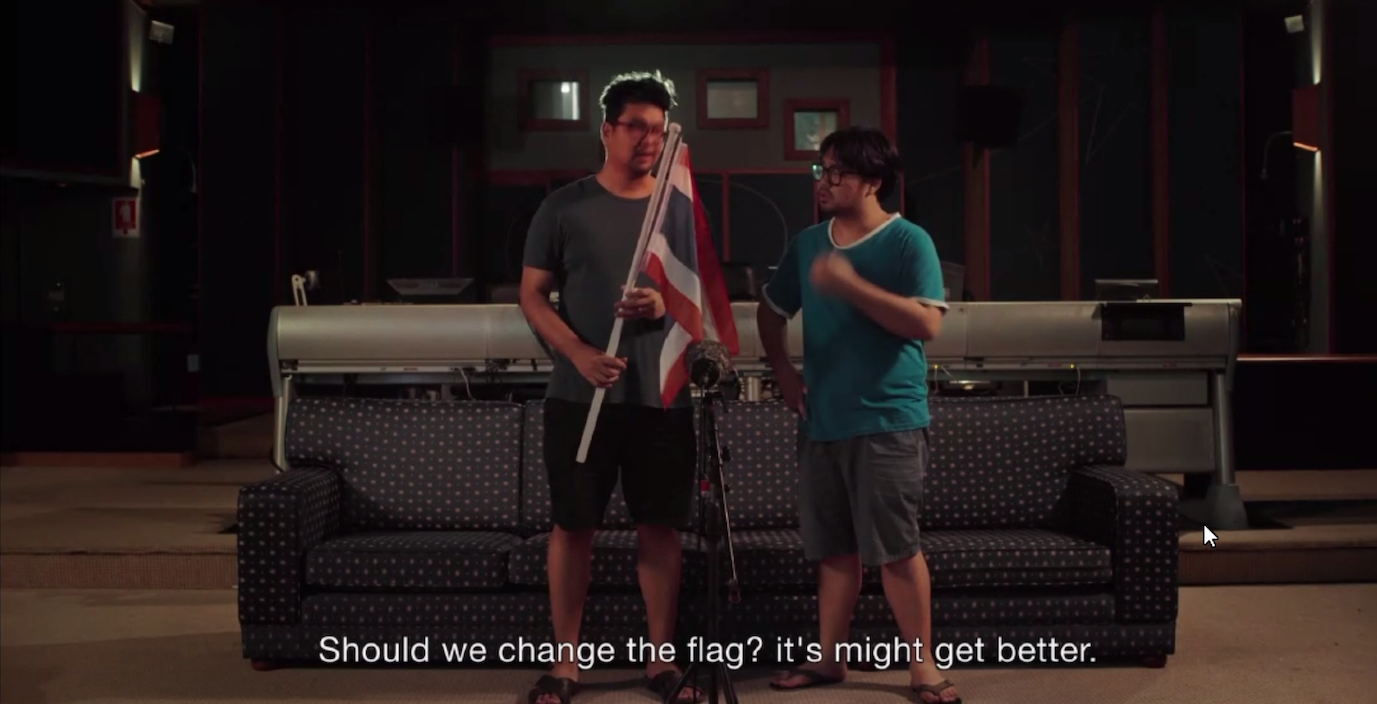
Yossy: This is of course only location sound, we just removed the sound from the first flag.
Tingli: Did this scene happen to you in real life?
Yossy: Not the flag one, it’s just a final joke that we thought about. The idea first came as I felt that if I want to share my political views in the film that no one cares about Thailand, even the Thai government doesn’t care about Thailand. So I felt like, the Thai flag has no sound. And to make it funnier, we have to compare it with another flag, so we had to decide which flag. Should I use China’s flag? the LGBT flag? In the end, America is safe in terms of making fun. Shot in 2017, and I’m quite a big fan of Donald Trump, you know? [laughs]
Tingli: I had the reverse experience when I was watching this scene because I didn’t think Thailand has no voice. I thought of the phrase “empty vessels make the most noise”. Our traits are more humble and modest. Sometimes even though we both do the same thing we don’t compliment and credit ourselves enough, we don’t make enough noise about the good things that we do. That was my takeaway from this scene. I would never think that sound or lack of sound can become a political statement, but this scene was really effective for me.
Yossy: The sound was quite loud when we waved the flag. I don’t have many American friends but sometimes they are too loud, also. To be honest,I did not claim this [intention] before, I claimed it after shooting it!
Tingli: So you had to tell the talents to not speak when they’re waving the Thai flag, because you knew you are going to use it?
Yossy: We used the location sound, we didn’t want to do ADR. Another funny thing: when we shot we decide to use a bigger room but when we had to do real audio post production we didn’t have the money to rent this room again! So we went to another smaller room… We spent for the location fees to shoot the film but for the mixing we didn’t have the budget.
Tingli: Oh no! It still sounds good but it just goes to show we spend more money for things we can see even us as sound people, you as a sound trained director, you also spend more money on your visuals. If we talk about Hollywood, when they call it principle photography, their aim is to capture the best image. Everything else can be replaced, like the sound can be ADR-ed. This kind of mindset has made sound quality suffer on set, unfortunately…
Yossy: That’s what we talked about before when we prepared this talk; “the only good sound comes from angry sound men”.
Tingli: Yes, totally. We have to shout, can you keep quiet for two minutes!
If you’re too nice as a sound recordist, your whole entire craft is already being you know ignored… so if you’re not angry, you can’t try to get your way you know what I mean? Maybe your next film should be called An Angry Soundman.
Yossy: As film was self-funded film, we thought initially that we didn’t need the sound room to shoot the film. But if you use it, it makes the film more professional, so we decided to recce and use one. I asked the technician, what can this do? He showed us everything and I was like oh, I know my ending shot, thank you. So it came from the recce not on the script.
Tingli: For anyone who doesn’t know why this function exists, this is not for sound people to play disco while they’re mixing; it’s to check that the hardware is all fine, that the faders can move the lights can be on and off at the right colour.
There as another thing we talked about while preparing which is how does cultural knowledge and context impact sound design?
One of the things that I talked about was when we worked with a foley partner in Europe. When they returned us the indoor scenes at home all the footsteps were with shoes on and we had to explain to them: no, we don’t wear shoes indoors, in Asia, we are barefoot at home and they had to redo all the footsteps. Even when we rely on sound effects you can buy, usually made by westerners, like when you hear applause you can tell it’s like a Caucasian audience, it doesn’t really sound Asian. How do you address this in your films?
Yossy: That’s a hard question. So it’s back to the same thing: if I notice, I’m not okay with it, but sometimes I don’t notice. My sound guy is a motorcycle guy and he can identify, no, this is not the pipe of this motorcycle, this is the female pipe, male pipe and I’m not a motorcycle guy but I know what he means. If the audience hears it, they will say it’s a bad sound. And some of my friends work on documentary projects abut the environment. We see a bird as a bird but every bird sound is different.
So we have to improve our knowledge about everything that makes sound, to make it perfect.
Tingli: Your knowledge adds to the authenticity of the film. If someone was to make a Singapore or Thai film and they added crickets from the desert, the local audience would just not buy it.
When I was working on Pop Aye [directed by Kirsten Tan], set in Thailand — I’m a stickler for authentic bird sounds; I know it sounds a bit weird [laughs] — I made my team research what kinds of birds exist in this part of the world. You’ll be amazed how many bird watcher websites exist, with photos of the bird and recordings of the birdsong. We found those in this region and as [the protagonist] travelled to the countryside, the sounds of the birds changed. We found the sounds of the birds we liked, and we tried to look for those exact birds in our sound library. We tried to be authentic even though we haven’t lived in Thailand, and that was very important for Kirsten and for us.
View the trailer for Pop Aye here and read an interview with Tingli about its sound design .
Tingli: And in Singapore film I always add the koel — the annoying bird that wakes you up in the morning. Like you said about the motorbike, there are so many things we do that just goes unnoticed but it sets you in and makes you believe the environment the film is set in.
Yossy: I agree but I’m not so sure everyone agrees with this.
Tingli: Maybe they don’t know.
It’s like one of those jobs where if you do it right, nobody will know you did your job. But once you do it wrong, once you can’t understand the dialogue or hear something that is amiss or unauthentic, then you are called out for it. But if you did your job well, nobody will even know you exist!
I just finished doing the mix and one of the notes the director gave was that “she sounds like she is driving a WRX and she should be driving a Toyota”. Stuff like that informs you about the character, even though you don’t see the car, you don’t know what car she is driving. I thought that was interesting.
Yossy: There is another thing where sometimes the real sound is bad and the fake sound is better.
Tingli: True. I guess the other side of the spectrum would be directors who are sticklers for the exact sound that that thing produces, but there is no emotional impact. If you added a different sound it would make you more emotionally engaged rather than the real sound.
So, since you were a sound person before, and aware of all the woes of a sound person, when you became a director did you then understand why sound people and sound were so neglected? Since you changed your role, did that change your opinion?
Yossy: I’ve tried to understand both sides because to get clean sound we have to spend a lot of time and sometimes the shooting day has only limited time. But we should still [strike a] balance cos you need the sound anyway. Even if you say f— it, we’ll do it in post, if you don’t like it then, you still need the sound.
Every time I work on my short film my shots are very simple and that means we have time to do many takes and we have time to record for really long. Mostly I record in the morning for two minutes [of the script / film] before lunch, three minutes before the afternoon [break], two minutes and before wrapping, another three minutes.
The lighting crew would not like me so much, but I can only do this when I’m the director and sound guy at the same time. When I’m only the sound guy I’m like oh okay, at least I’m not going to do post-production for this film! [laughs] No no, I’ll be more angry if I have to do post production for this film. Sometimes, if I know this film is not serious, it’s okay, let the production flow.
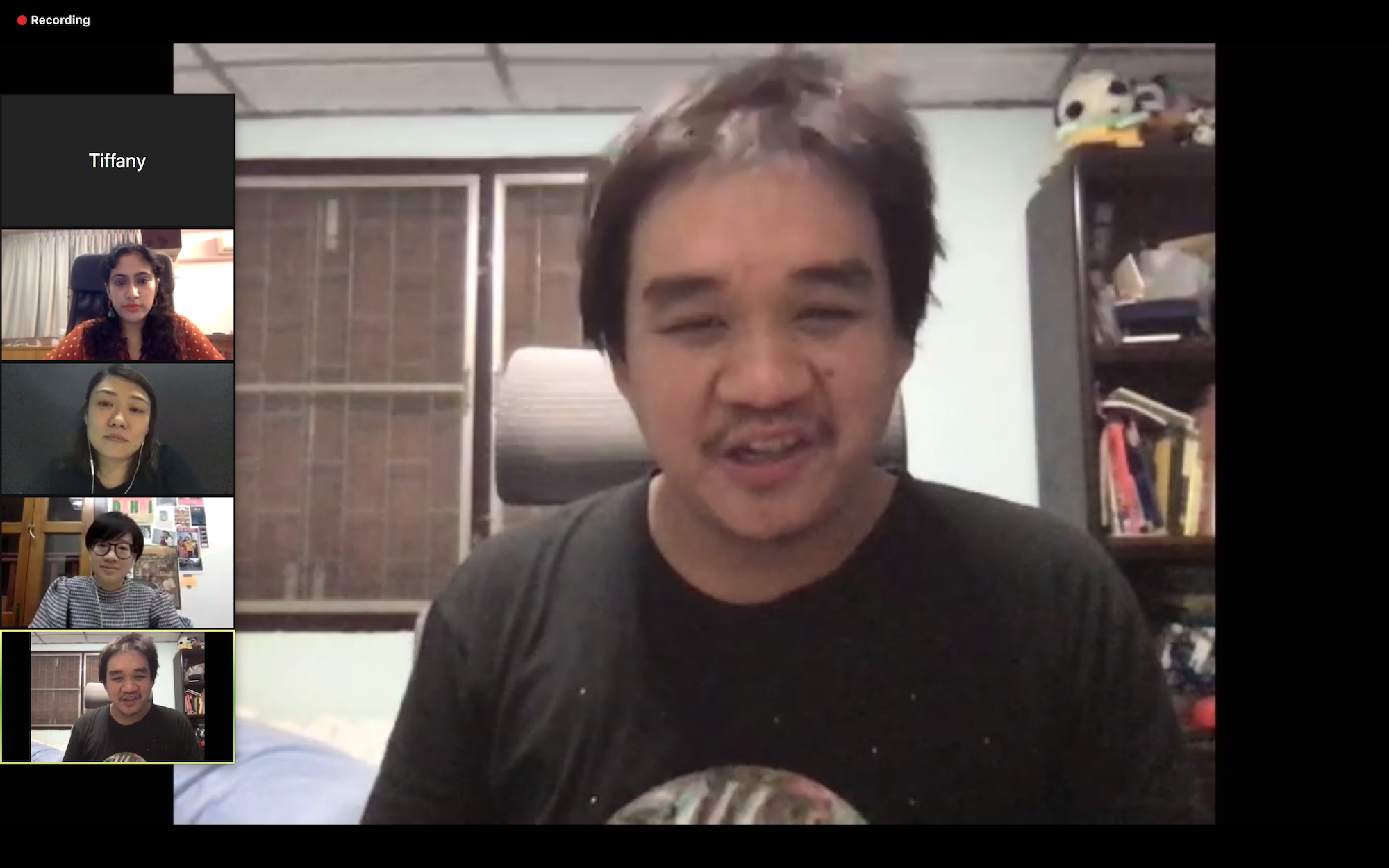
Thai filmmaker Sorayos “Yossy” Prapapan
Tingli: Since you have this authority to keep doing all this recording because you’re the director, did it benefit your film in the end?
Yossy: I admit that many times we recorded the sound but didn’t use it, but maybe we don’t use for that footage, but we use it for other footage. I’m the one who can benefit anyway, so I didn’t care!
I like the moment when we record the ambience and just go far away, go smoke or whatever, just a silent space. I like the chance to have this kind of moment. Maybe the producer didn’t like it though!
Tingli: You just reminded me — not many directors are led by sound but Hou Hsiao-hsien is a director whose imagery is dictated by sound. When he started filming, there was no sync sound in Taiwan. They were used to dubbing everything, and you know his characters are improvising all the time, and he improvises all his lines. When it’s time to dub the lines he cannot remember what he said on set.
He said that because of that, he felt his earlier films always lacked authenticity. He didn’t believe the characters and he felt it was because of the dub. When he made the first sync sound film in Taiwan, which I believe was A City of Sadness, he kept the camera static because the film camera was so noisy. They wrapped the camera with noise mufflers, and he didn’t allow the camera to move precisely so he could get good dialogue. Then he got the authenticity he felt was missing in his earlier films.
A City of Sadness (1989) by Hou Hsiao-hsien was the first sync sound feature-length film made in Taiwan. Read about the contributions made by sound engineer Tu Duu-chih here and here.
That was incredible because the sound dictated and created the stillness, the static cameras that he is now so famous for, the complex blocking and everything. When I watch your film, it reminds me of that too — the static shots and the authentic sounds. Like you said you didn’t use a single piece of ADR.
Yossy: I watched some of Hou Hsiao-hsien’s films. In his earliest films the sound was bad; I didn’t like it that much. Maybe that was the reason.
There is one term in sound post production that I am not so sure what it means. Tingli, can you explain what is a rerecording mixer?
Tingli: In the past, when sound was not digital, everybody was working on tapes of sound. You would record on quarter inch tapes, and you have a reel of dialogue. It’s similar to when you edit on film, where you are cutting film reels so sound did that as well on magnetic tapes. In the end, they will have one reel of edited dialogue, one reel of edited effects, one of music and they will play these three together with a clock sync and then they rerecord it into a new tape. This is why the term rerecording mixer; in the past there was no automation. Now what we can do everything digitally.
Yossy: Basically, it’s balancing the sound?
Tingli: Yes, it’s putting the sound in context. It’s not just about levels but also adding reverb, EQing certain things. They did all that live, so it was almost like a performance. Now the lines are blurring so if you’re a sound designer, you also mix, and if you’re a sound mixer you also have to do sound design. In fact, sometimes the sound recordist is the post sound person. Sometimes all of these people are also the composer, so technology has lowered the entry level. Now, anybody with [software like] Logic, Pro Tools, Audacity can start to create sound design.
The entry level is lowered but our creativity shouldn’t.
Audience Member: What are some of your sources of inspiration? Where do you seek ideas in terms of building your knowledge in sound?
Yossy: I care about politics and also sometimes I really care about filmmaking, so most of the films I’ve made are about filmmaking and if I can, I want to reflect my political views. If I shot the film in 2017, I want it to reflect my political views in 2017, what was happening — something like that.
Tingli: My first inspiration always comes from watching the film for the first time, because I am someone who reacts to what I see. When I’m watching a film I’m going to work on, I start to hear the accompanying sound design. I respond to what I receive or even from a script stage. And for things I don’t know, I will just google for it. Forums are wonderful, Facebook groups and other people are very important resources for me.
Watch this short video on Tingli and her career in sound.
Audience Member: Is the experience of sound impacted or compromised by the rise in people consuming media through their smartphones and laptops?
Tingli: There is always this argument: should we watch films on Netflix, laptops, or our phones, or should we just go to the movies? I feel like a lot of this content wouldn’t even be consumed if it wasn’t so easily available. In a sense I am very torn because of course for any film I work on, i would like it to be seen on the big screen, in a black box…you know, an experience where you’re not ironing, you’re not having screaming kids around, not on your crappy phone speakers. But at the same time if it hadn’t been made accessible to you, you may never ever have watched it. That is always my dilemma; maybe I’d rather someone watch some of my works crappily than not at all [laughs].
Audience Member: Do you have any thoughts on new audio technologies in filmmaking, examples being mono vs. surround or the practice of using faders vs computers?
Tingli: You cannot take technology and its advancement away from filmmaking; it’s impossible. I mean, do you still want to be watching VCDs? But many people will argue you lose the warmth of film grain, when you listen to MPs vs vinyl. The experience will be different, but it is still an inevitability for technology to improve. So then it boils down to how you use it.
Personally, I love new technology, I love that we are going into immersive sound formats. If it’s not engaging enough, it will never succeed. It’s like 3D TV. There was a period where it was hot, but it never took off because people didn’t believe in it, didn’t engage with it. The tech that engages the audience would survive and for me now I’m putting my bet on Dolby Atmos, on immersive sound.
As for the practice of using faders vs computers,
to me it’s just a tool, in the end it’s your ears, your sensibility, your taste, not whether you use the mouse to do that beautiful fade out or if you used a fader. It doesn’t make a difference. It is about the outcome.
Yossy: I admit that sometimes I cannot realise if something is mono or stereo if I watch something on a laptop. So it’s helpful to go through the proper gear or even just headphones. It’s good, I mean now we hear more; back then we could not hear the sound behind us. I agree, I like technology in sound.
Audience Member: Tingli, since most of the sound library SFX (special effects) are from abroad, do you have a collection of Singaporean sounds you use for local films and do you record more?
Tingli: We do go out and record our own sound libraries because some of the sounds unique to us are just not easily available, for example like flip flop footsteps. The ones in the sound libraries are very proper but the ones you hear in our HDB coffeeshops, they slide, they drag their feet…the wishy washy kind of sound, we have to record. Stuff like cooking in a wok instead of a barbecue sizzling, the wok sound is totally different, I couldn’t find it in sound libraries. We go out and record the MRT, Malay weddings, Chinese funerals, all of this. There are groups of people in Singapore who are trying to create a Singaporean sound library; that’s really commendable. Some of them are in this Zoom call!
Yossy: The traffic lights in Singapore are also different! [laughs] Have you ever used the same source for multiple films or you use them only once and never again?
Tingli: I will use them again.
Yossy: I think different people have different opinions on this.
Tingli: I don’t think I have enough resources to record new sounds for every film. But I also never use the sound effect on its own; I will always layer it. Even if I reuse it, the way I treat it or whatever reverb that I add to it, however I process it, will be different. Maybe I’ve been reusing stuff and people can tell already! [laughs] but I think people cannot tell it’s repeated sounds. But I know in Pixar, for example, they always record new sounds, they never access the library of an old film.
Yossy: It’’s funny because Pixar films always sound the same!
Tingli: Maybe they just keep rerecording the same thing. They’ve done it so many times!
Death of the Sound Man, along with other short films by Southeast Asian filmmakers, is available to rent on the Objectifs Film Library.

